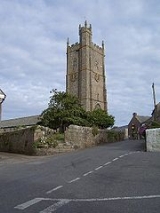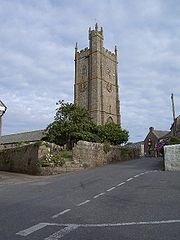
Paul, Cornwall
Encyclopedia

Cornwall
Cornwall is a unitary authority and ceremonial county of England, within the United Kingdom. It is bordered to the north and west by the Celtic Sea, to the south by the English Channel, and to the east by the county of Devon, over the River Tamar. Cornwall has a population of , and covers an area of...
, United Kingdom
United Kingdom
The United Kingdom of Great Britain and Northern IrelandIn the United Kingdom and Dependencies, other languages have been officially recognised as legitimate autochthonous languages under the European Charter for Regional or Minority Languages...
. It is situated two miles (3 km) south of Penzance
Penzance
Penzance is a town, civil parish, and port in Cornwall, England, in the United Kingdom. It is the most westerly major town in Cornwall and is approximately 75 miles west of Plymouth and 300 miles west-southwest of London...
and one mile (1.6 km) south of Newlyn
Newlyn
Newlyn is a town and fishing port in southwest Cornwall, England, United Kingdom.Newlyn forms a conurbation with the neighbouring town of Penzance and is part of Penzance civil parish...
.
The village of Paul is represented on Penzance Town Council. For elections to Cornwall Council (the unitary authority) Paul is within the three-member single Penzance Electoral division.
Like many Cornish communities Paul has its own community celebration. Paul Feast is held on the Sunday nearest 10 October every year when the village is decorated and a civic service takes place on the Sunday of the feast itself led by the Mayor of Penzance. The feast may be an example of the Celtic practice of celebrating Samhain
Samhain
Samhain is a Gaelic harvest festival held on October 31–November 1. It was linked to festivals held around the same time in other Celtic cultures, and was popularised as the "Celtic New Year" from the late 19th century, following Sir John Rhys and Sir James Frazer...
or Allantide
Allantide
Allantide is a Cornish festival that was traditionally celebrated on 31 October elsewhere known as Hallowe'en. The festival itself seems to have pre-Christian origins similar to most celebrations on this date, however in Cornwall it was popularly linked to St Allen or Arlan a little known Cornish...
.
History
Much of the history of Paul is connected with its parish churchChurch of England parish church
A parish church in the Church of England is the church which acts as the religious centre for the people within the smallest and most basic Church of England administrative region, known as a parish.-Parishes in England:...
. The church itself
Paul Parish Church
Paul Parish Church is a parish church in the Church of England located in Paul, Cornwall, UK.-History:The church is said to have been founded in 490 by Paul Aurelian, a Welsh saint. The church building is medieval but was largely destroyed in a raid by the Spanish in 1595.. It was rebuilt by...
is said to have been founded in 490
490
Year 490 was a common year starting on Monday of the Julian calendar. At the time, it was known as the Year of the Consulship of Faustus and Longinus...
, a very uncertain date and not documented, by Paul Aurelian
Paul Aurelian
Paul Aurelian is a 6th century Welsh saint, who became one of the seven founder saints of Brittany....
, a Welsh saint known in Brittany
Brittany
Brittany is a cultural and administrative region in the north-west of France. Previously a kingdom and then a duchy, Brittany was united to the Kingdom of France in 1532 as a province. Brittany has also been referred to as Less, Lesser or Little Britain...
as Paol Aurelian in Breton. There is no historical evidence to support his ever coming to West Penwith. He was founder of the cathedral
Cathedral
A cathedral is a Christian church that contains the seat of a bishop...
at Saint-Pol-de-Léon
Saint-Pol-de-Léon
Saint-Pol-de-Léon is a commune in the Finistère department in Bretange in northwestern France, located on the coast.It is famous for its 13th-century cathedral on the site of the original founded by Saint Paul Aurelian in the 6th century. It has kept a unique architecture, such as Notre-Dame du...
, the city named after him. However this church could have been dedicated to Paul the Apostle, or Paulinus of York, there is no documentary evidence to prove any of these three Saint Pauls was the original dedicatee of the church. It was only named 'St. Pol-de-Leon' in 1907 and is probably connected with Henry Jenner who (with W C Borlase) opposed alleged 'Englishness' and stamp consistent spelling of Cornish place names on OS maps.
The first documented name for Paul Church comes from the registers of Bishop Bronescombe
Walter Branscombe
Walter Branscombe was Bishop of Exeter from 1258 to 1280.-Life:...
, when on 2 May 1259 the first recorded priest was installed, as Rector in his own right, in the 'Ecclesie Sancti Paulini'--Church of St. Paulinus.
Paul village, original name 'Brewinney' and its church have a long association with Mousehole
Mousehole
Mousehole is a village and fishing port in Cornwall, United Kingdom. It is situated approximately 2½ miles south of Penzance on the shore of Mount's Bay.The village is in the civil parish of Penzance...
and the church has served as this community's parish church since its inception. Paul was one of the communities along with Mousehole, Newlyn, and Penzance to be destroyed in the Spanish raid of 1595
Battle of Cornwall
The Battle of Cornwall was a Spanish raid in Cornwall in 1595 during the Anglo-Spanish war of 1585-1604. It was the only attempted Spanish raid of the area since Fernando Sánchez de Tovar's destruction of English coastal towns in the 14th century.-Landings:...
carried out by Carlos de Amésquita
Carlos de Amésquita
Carlos de Amésquita was a Spanish naval officer of the 16th century. He is remembered for an action whilst on a routine patrol, known as the Battle of Cornwall, during the Anglo-Spanish War 1585–1604....
.
Langdon (1896) recorded the existence of five stone crosses in the parish.
Geography
To the north of the civil parish is Chyenhal Moor, a Site of Special Scientific InterestSite of Special Scientific Interest
A Site of Special Scientific Interest is a conservation designation denoting a protected area in the United Kingdom. SSSIs are the basic building block of site-based nature conservation legislation and most other legal nature/geological conservation designations in Great Britain are based upon...
noted for its biological
Flora and fauna of Cornwall
Cornwall is the county that forms the tip of the southwestern peninsula of England; this area has a mild and warm climate regulated by the Gulf Stream...
interest.
Cornish language (memorials)
Within the village churchyard there is a memorial to Dolly PentreathDolly Pentreath
Dolly Pentreath, or Dorothy Pentreath was probably the last fluent native speaker of the Cornish language, prior to its revival in 1904 and the subsequent small number of children brought up as bilingual native speakers of revived Cornish.She is often stated to have been the last monoglot speaker...
, reputedly and disputedly the last native speaker of Cornish
Cornish language
Cornish is a Brythonic Celtic language and a recognised minority language of the United Kingdom. Along with Welsh and Breton, it is directly descended from the ancient British language spoken throughout much of Britain before the English language came to dominate...
. This memorial was placed there by Louis Lucien Bonaparte
Louis Lucien Bonaparte
Louis Lucien Bonaparte was the third son of Napoleon's second surviving brother, Lucien Bonaparte. He was born at Thorngrove, mansion in Grimley, Worcestershire, England, where his family were temporarily interned after having been captured by the British en route to America A philologist and...
, a relative of Napoleon Bonaparte
Napoleon I of France
Napoleon Bonaparte was a French military and political leader during the latter stages of the French Revolution.As Napoleon I, he was Emperor of the French from 1804 to 1815...
, and the Vicar of Paul in the 19th century.
The Cornish language
Cornish language
Cornish is a Brythonic Celtic language and a recognised minority language of the United Kingdom. Along with Welsh and Breton, it is directly descended from the ancient British language spoken throughout much of Britain before the English language came to dominate...
writers Nicholas Boson
Nicholas Boson
Nicholas Boson was a writer in, and preserver of, the Cornish language. He was born in Newlyn to a landowning and merchant family involved in the pilchard fisheries....
, Thomas Boson
Thomas Boson
Thomas Boson was a writer in the Cornish language and the cousin of Nicholas and John Boson. Thomas helped William Gwavas in his Cornish language research, and wrote an inscription in Cornish for Gwavas's hurling ball. He also made translations of the Ten Commandments, the Apostles' Creed, the...
and John Boson
John Boson (writer)
John Boson was a writer in the Cornish language. The son of Nicholas Boson, he was born in Paul, Cornwall. He taught Cornish to William Gwavas. His works in Cornish include an epitaph for the language scholar John Keigwin, and the "Pilchard Curing Rhyme". He also translated parts of the Bible, the...
are all buried in Paul Churchyard, and a monument in the church by John Boson (to Arthur Hutchens, d. 1709) is the only surviving lapidary inscription in traditional Cornish.

